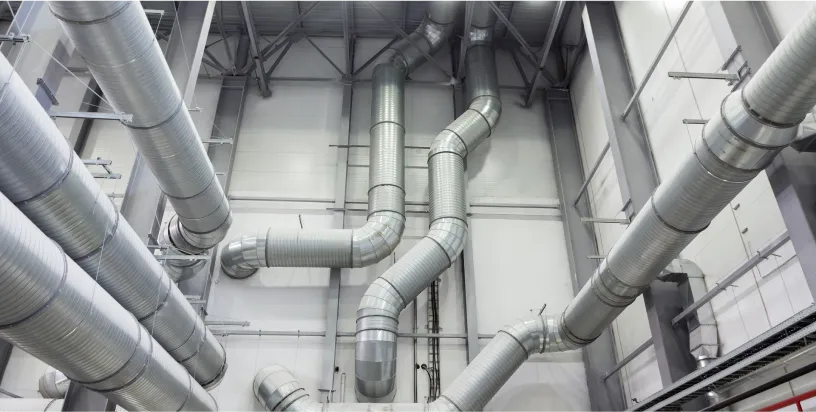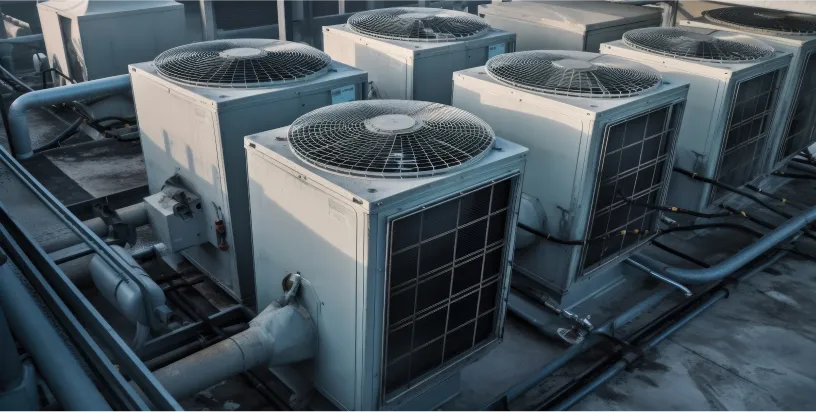Thank you! Your submission has been received!
Oops! Something went wrong while submitting the form.

Efficient Heating, Ventilation, and Air Conditioning (HVAC) systems are indispensable elements of industrial infrastructure. In this comprehensive guide, we delve into the critical role of HVAC systems in industrial settings, the challenges faced by businesses, and strategic approaches to optimizing performance while managing costs effectively.
Industrial environments are dynamic workplaces where employee comfort directly impacts productivity and operational efficiency. HVAC systems play a pivotal role in maintaining optimal indoor conditions, ensuring that employees can work comfortably regardless of external weather conditions. From regulating temperatures to controlling humidity levels, a well-designed HVAC system fosters a conducive environment that promotes employee well-being and enhances productivity.
In today's regulatory landscape, industrial facilities are subject to stringent environmental standards aimed at minimizing energy consumption and reducing carbon emissions. HVAC systems, accounting for a significant portion of a building's energy usage, are under scrutiny to meet these sustainability objectives. By adopting energy-efficient technologies and implementing eco-friendly practices, businesses can not only comply with regulations but also reduce operational costs and demonstrate corporate responsibility.
Operational efficiency is paramount for industrial businesses striving to maintain a competitive edge in a challenging market. HVAC systems, being essential components of facility infrastructure, significantly impact operational costs and resilience. By investing in energy-efficient equipment, implementing proactive maintenance strategies, and leveraging innovative technologies, businesses can optimize HVAC performance, minimize downtime, and maximize cost savings over the system's life cycle.

Pitfall: One of the most common pitfalls in HVAC system design is inadequately sizing equipment to meet operational demands. Oversized systems lead to wasted energy and unnecessary expenses, while undersized systems fail to maintain desired indoor conditions, resulting in discomfort and inefficiency.
Solution: Collaborating with experienced HVAC engineering consultants and utilizing advanced modeling tools allows businesses to accurately size and design HVAC systems, optimizing performance and efficiency while minimizing waste.
The integration of smart technologies and data analytics has revolutionized HVAC system maintenance, enabling predictive and proactive approaches to equipment upkeep. Real-time monitoring, coupled with predictive analytics algorithms, empowers businesses to detect potential issues before they escalate into costly disruptions. By implementing remote monitoring solutions, IoT-enabled sensors, and predictive maintenance platforms, businesses can optimize HVAC performance, reduce maintenance costs, and enhance operational reliability.
Sustainability is no longer a choice but a necessity for industrial businesses seeking to future-proof their operations. By embracing sustainable practices such as energy-efficient HVAC systems, renewable energy integration, and green building certifications, businesses can reduce their environmental footprint while reaping financial benefits. Investing in sustainability not only aligns with regulatory requirements but also enhances brand reputation, attracting environmentally conscious customers and investors.

Challenge: The manufacturing facility in Alberta faced challenges with its outdated cooling system, including inefficient cooling, high energy consumption, and frequent breakdowns, leading to operational disruptions and increased maintenance costs.
Solution:
Result: The upgraded cooling system delivered measurable benefits, including improved cooling performance, a 20% reduction in energy consumption, and fewer maintenance issues. These enhancements translated into significant cost savings and enhanced operational reliability for the manufacturing facility.
Challenge: The warehouse facility in Calgary experienced indoor air quality issues and ventilation challenges, leading to employee discomfort and health concerns. Poor ventilation contributed to the accumulation of pollutants and allergens, adversely affecting employee well-being and productivity.
Solution:
Result: The optimized ventilation system led to tangible improvements in indoor air quality, reducing pollutants and allergens and creating a healthier work environment. This resulted in increased employee satisfaction, reduced absenteeism, and improved overall productivity.
Challenge: The distribution center in Edmonton faced escalating heating costs during harsh winter conditions, impacting operational budgets and sustainability goals. Traditional heating systems were inefficient and costly to operate, posing financial and environmental challenges.
Solution:
Result: The transition to energy-efficient heating technologies resulted in significant cost savings, with a 60% reduction in heating expenses during winter months. Additionally, the adoption of renewable energy solutions enhanced the distribution center's environmental sustainability profile, supporting its commitment to carbon footprint reduction and responsible resource management.

In conclusion, optimizing HVAC systems in industrial spaces requires a multifaceted approach encompassing design optimization, sustainability initiatives, and proactive maintenance strategies. By addressing common pitfalls and leveraging practical solutions, businesses can enhance operational efficiency, reduce costs, and future-proof their operations for long-term success. The case studies provided demonstrate real-world applications of these principles, showcasing the tangible benefits of strategic HVAC system investments in enhancing operational resilience and driving sustainable growth.